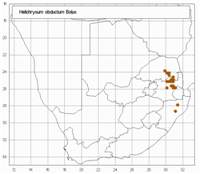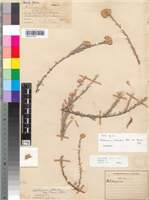Origin of name:
obductus = covered over, overspread
Diagnostic characters:
Densely branched and very floriferousLeaves soft, woolly-hairyFlowering branches leafy up to the inflorescenceCream or light yellow straw-coloured bractsMedium-sized heads
Description:
A well-branched shrub, branches either prostrate or erect to c. 600 mm, branchlets silky grey-felted, closely leafy. Leaves erect or spreading, imbricate, c. 5-20 x 1-2 (-3) mm, linear, acute or subacute, mucronate, slightly hooked, base half-clasping, slightly decurrent, margins revolute, both surfaces enveloped in silvery tissue-paper-like indumentum that hides dense coarse hairs below. Heads homogamous, campanulate, 4-6 (-7) x 3-6 (-7) mm, solitary or 2-3, c. 20 in very compact corymbose clusters, often webbed to surrounding reduced leaves, at the branchlet tips. Involucral bracts in 4-5 series, outermost shorter, inner subequal, loosely imbricate, slightly exceeding flowers, scarcely radiating, tips obtuse or acute, tawny, glossy. Receptacle with fimbrils equaling the ovaries. Flowers 15-44. Achenes not seen, ovaries, glabrous. Pappus bristles many, scabrid, about equaling corolla, bases cohering by patent cilia.
Flowers can be found in any month, but the main season seems to be between April and September.
Distribution:
Grows in rocky places, sometimes prostrate on rock sheets, often erect among boulders and outcrops on rocky ridges. Ranges from the Wolkberg south through the highlands of Mpumalanga to the mountains of N. KwaZulu-Natal and across the high ground to the Noodsberg, then to Kloof, near Durban, and Ismont, near Mid Illovo, south of Durban.
Grassland and Savanna Biomes.
Notes:
Very variable over the distribution range. Twiggy shrubs with solitary heads and short more or less appressed leaves look very different from loosely branched specimens with long lax leaves and heads in small glomerules, but many intermediate states occur, making the recognition of infraspecific categories impossible. Just such an intermediate plant with heads solitary or few in small glomerules and short but lax leaves, was described as var. laxior, now relegated to synonymy.
Taxonomy:
Literature:
Helichrysum obductum H. Bol. in Trans. S. Afr. phil. Soc. 18; 391 (1907); Moeser in Bot. Jb. 44: 285 (1910); Hilliard, Compositae in Natal 171 (1977).
Type:
Lectotype: KwaZulu-Natal, Great Noodsberg, 2 000�3 000 ft, Wood 5292 (BOL; E; NH, isolecto.).
Synonym(s):
H. obductum var. laxior H. Bol., l.c. Type: Mpumalanga, Drakensberg, Devil's Kantoor, Sept. 1886, Bolus 7806 (BOL, holo.; K; PRE, iso.).
Vouchers:
Codd 7602 (K; PRE, solitary heads, short appressed leaves); Hilliard & Burtt 9949 (E; K; MO; NU; PRE; S, several heads in glomerules, long, lax leaves); Rogers 19507 (PRE, few heads in glomerules, short lax leaves).

_sml.jpg)
_sml.jpg)

